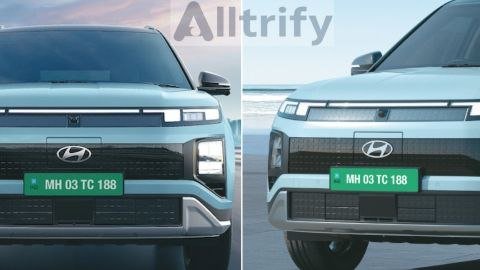Table of Contents
Design Highlights of the Hyundai Creta Electric
The Hyundai Creta Electric showcases a distinct exterior that not only emphasizes its electric capabilities but also retains the modern aesthetic seen in its internal combustion engine counterpart. At the forefront of this design evolution is the redesigned front fascia, characterized by a striking pixelated pattern. This feature not only aligns with the contemporary design trends but also signifies its electric identity, differentiating it from the traditional offerings in the Creta lineup.
An essential aspect of this design is the prominent charging flap, which is cleverly integrated into the front, prominently adorned with the Hyundai logo. This flap, visually appealing yet functional, serves as a reminder of the advanced technology that underpins the Hyundai Creta Electric. Furthermore, the inclusion of active air flaps is noteworthy, as these elements play a crucial role in enhancing the vehicle’s aerodynamic efficiency. They serve dual purposes by improving airflow during driving conditions while ensuring effective battery cooling, which is vital for the longevity and performance of any electric vehicle.
Interior Features and Technology
The interior of the Hyundai Creta Electric has been meticulously designed, featuring a dual-tone black and white cabin theme that provides an aesthetically pleasing environment for both the driver and passengers. This design mirrors the popular styling of the conventional Creta while embracing a modern, electric twist that distinguishes it in the evolving EV market.
A prominent feature of the interior is the steering wheel, which takes inspiration from the Hyundai Ioniq 5. This not only enhances the visual appeal but also elevates the driving experience with its user-friendly layout and ergonomic design. Additionally, adjustments to the lower center console have been made to accommodate the unique controls necessary for an electric vehicle, ensuring that all functions are intuitive and accessible to the driver. This thoughtful arrangement highlights Hyundai’s commitment to merging style with functionality in the Creta Electric.
The dashboard is equipped with a dual-screen setup, seamlessly integrating digital displays for navigation, infotainment, and vehicle status. This feature enhances the user experience by allowing easy access to essential information at a glance. Furthermore, luxury features such as a panoramic sunroof add an open and airy feel to the cabin, elevating the overall ambiance and comfort for passengers.
In terms of technology, the Hyundai Creta Electric is at the forefront with its innovative vehicle-to-load (V2L) charging capability. This allows users to harness the car’s battery to power external devices, providing unparalleled convenience for adventures and daily activities alike. With its array of premium features and advanced technology, the Creta Electric sets a new standard for electric vehicles in India, making a compelling case for potential buyers looking for luxury and versatility in an affordable EV.
Battery Options and Range Performance
The Hyundai Creta Electric is designed to cater to the needs of the modern consumer, offering two distinct battery pack options: a 42 kWh variant and a more robust 51.4 kWh variant. Each of these options provides an impressive range, making the vehicle practical for daily commutes and longer trips alike. The ARRAI-claimed range for the 42 kWh battery is a commendable 390 km, while the 51.4 kWh battery boosts this figure to an outstanding 473 km. This significant difference showcases the flexibility of the Hyundai Creta Electric, allowing consumers to choose a battery that fits their personal driving patterns and lifestyle.
For many potential buyers, the practicality of an electric vehicle is greatly influenced by its charging capabilities. The Hyundai Creta Electric excels in this regard, equipped with features that enhance the overall user experience. When utilizing a DC fast charger, the Creta Electric can be charged from 10% to 80% in approximately 45 minutes, providing a convenient solution for those on the go. This rapid charging feature addresses one of the most common concerns regarding electric vehicles: charging time and convenience.
Additionally, the inclusion of an 11 kW AC charger further diversifies the Hyundai Creta Electric’s charging options. With this AC charger, users can expect a more gradual charge, beneficial for overnight charging at home. This efficiency allows for seamless transition into the electric realm, making it easy for new EV users to adapt. The various battery options, combined with the efficient charging capabilities, underscore the Hyundai Creta Electric’s position as a formidable contender in the affordable EV market, appealing to consumers who prioritize both range and flexibility.
The Hyundai Creta Electric in the Indian Market
The Indian automotive landscape is undergoing a significant transformation with the increasing emphasis on electric vehicles (EVs). Among the range of electric SUVs emerging in the market, the Hyundai Creta Electric stands out as a remarkable addition, particularly considering its status as the most affordable all-electric offering from the renowned automotive manufacturer. As the demand for compact SUVs continues to grow, the introduction of the Creta Electric positions Hyundai strategically within this competitive segment.
Pricing plays a crucial role in the success of any vehicle, and the Hyundai Creta Electric aims to attract a broad customer base with a well-thought-out pricing strategy. By offering a compelling combination of features, technology, and efficiency at a competitive price point, Hyundai is poised to gain traction among Indian consumers looking for sustainable transport options without substantially increased costs. This strategy not only reflects an understanding of market needs but also highlights the brand’s commitment to making electric mobility accessible to the masses.
In comparison to its competitors within the compact SUV segment, the Hyundai Creta Electric brings several advantages. While conventional rivals are typically equipped with internal combustion engines, the Creta Electric capitalizes on the growing consumer preference for eco-friendly vehicles. The transition towards electric vehicles is particularly vital for India, given its commitment to reducing carbon emissions and addressing air pollution. Hyundai’s entry into the EV segment with the Creta Electric not only caters to the demands of eco-conscious consumers but also emphasizes the automotive industry’s gradual shift towards more sustainable practices.
As the market embraces electric options, the impact of the Hyundai Creta Electric is expected to resonate across various dimensions—empowering consumers with economical, eco-friendly choices and inspiring other manufacturers to innovate. The significance of this vehicle in catalyzing the shift to electric mobility in India cannot be understated, as it aligns seamlessly with the growing aspiration for sustainable transportation solutions.





